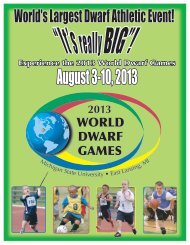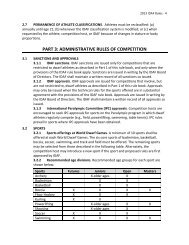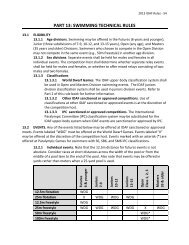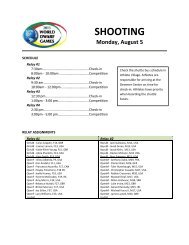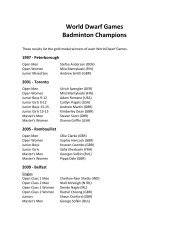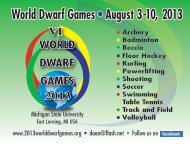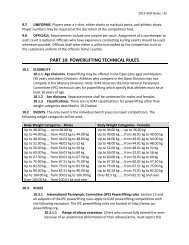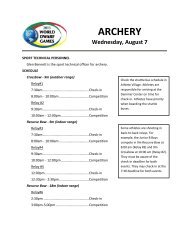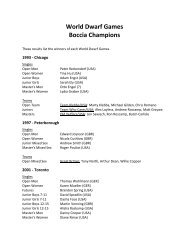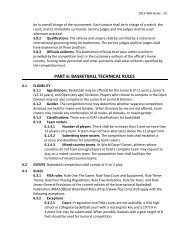Classification Form - 2013 World Dwarf Games
Classification Form - 2013 World Dwarf Games
Classification Form - 2013 World Dwarf Games
You also want an ePaper? Increase the reach of your titles
YUMPU automatically turns print PDFs into web optimized ePapers that Google loves.
Athlete <strong>Classification</strong> Information<br />
Athlete's Name: _________________________________________<br />
Date of Birth: Month ___________Day_________Year __________<br />
Gender: ________Male01 ________ Female02<br />
Athlete's Country:________________________________________<br />
Medical Issues that may affect classification: __________________<br />
______________________________________________________<br />
______________________________________________________<br />
INSTRUCTIONS:<br />
STANDING<br />
HEIGHT<br />
_____.___ cm<br />
SITTING<br />
HEIGHT<br />
_____.___ cm<br />
SHOULDER<br />
HEIGHT<br />
_____.___ cm<br />
right side<br />
_____.___ cm<br />
left side<br />
IDAF ATHLETE CLASSIFICATION FORM<br />
MEASUREMENTS<br />
Type of <strong>Dwarf</strong>ism (check):<br />
[ ]01 Achondroplasia<br />
[ ]02 Cartilage hair hypoplasia<br />
[ ]03 Diastrophic dysplasia<br />
[ ]04 Hypoachondroplasia<br />
[ ]05 Morquio<br />
[ ]06 OI - Osteogenesis imperfecta<br />
[ ]07 Primordial dwarfism<br />
[ ]08 Pseudoachondroplasia<br />
[ ]09 SEDc - Spondyloepipheseal dysplasia congenita<br />
[ ]10 SEDt - Spondyloepipheseal dysplasia tarda<br />
[ ] Other (specify): _____________________________<br />
Measurements must be conducted by an adult. That person should be at eye-level for each measurement.<br />
Measure to the nearest half centimeter. Measurements must be reported using the metric system.<br />
The data that you submit will help the International <strong>Dwarf</strong> Athletic Federation to refine the classification system. Thank you for your<br />
cooperation.<br />
Instructions:<br />
1. Bare feet. No shoes or stockings.<br />
2. Stand tall with back to the wall, head erect, shoulders back, and feet<br />
together.<br />
3. Place a book or carpenter's square (something with a right angle) with one<br />
side against the wall and another side atop the head.<br />
4. Mark the wall at the point corresponding to the top of the head.<br />
5. Measure from the floor to the wall marking.<br />
Instructions:<br />
1. Place a bench or stool with a flat, level sitting surface against a wall.<br />
2. Mark the height of the bench or stool on the wall.<br />
3. Sit tall on the bench with back to the wall, head erect, and shoulders back.<br />
4. Place a book or carpenter's square (something with a right angle) with one<br />
side against the wall and another side atop the head.<br />
5. Mark the wall at the point corresponding to the top of the head.<br />
6. Measure between the two markings.<br />
Instructions:<br />
1. Place a bench or stool with a flat, level sitting surface against a wall.<br />
2. Mark the height of the bench or stool on the wall.<br />
3. Sit tall on the bench with back to the wall, head erect, and shoulders back.<br />
4. Place a book or carpenter's square (something with a right angle) with one<br />
side against the wall and another side atop one of the athlete's shoulders.<br />
5. Mark the wall at the point corresponding to the top of the shoulder.<br />
6. Measure between the two markings.<br />
Page 6 of 22
Athlete <strong>Classification</strong> Information (cont.)<br />
SITTING<br />
VERTICAL<br />
REACH<br />
_____.___ cm<br />
right arm<br />
_____.___ cm<br />
left arm<br />
ARM SPAN<br />
_____.___ cm<br />
HALF ARM<br />
SPAN<br />
_____.___ cm<br />
right arm<br />
_____.___ cm<br />
left arm<br />
ARM LENGTH<br />
_____.___ cm<br />
right arm<br />
_____.___ cm<br />
left arm<br />
HEAD<br />
CIRCUMFERENCE<br />
_____.___ cm<br />
Instructions:<br />
1. Place a bench or stool with a flat, level sitting surface against a wall.<br />
2. Mark the height of the bench or stool on the wall.<br />
3. Sit tall on the bench with back to the wall, head erect, and shoulders back,<br />
and both arms raised as far as possible over the same side shoulder.<br />
4. Place a book or carpenter's square (something with a right angle) with one<br />
side against the wall and another side atop the fingertip with the highest<br />
reach.<br />
5. Mark the wall at the point corresponding to the top of the fingertip.<br />
6. Measure between the two markings.<br />
7. Repeat for the other arm.<br />
Instructions:<br />
1. Wear a thin, sleeveless shirt.<br />
2. Stand in a corner of the room, with back to one wall, feet about shoulder<br />
width apart, and the fingertips of one hand touching a perpendicular side wall.<br />
3. Stand tall with head erect, shoulders back, both arms raised to a horizontal<br />
position, hands at same level as shoulders, and thumbs up.<br />
4. Reach as far as possible from the fingertips of the right hand to the fingertips<br />
of the left hand.<br />
5. Mark the farthest reach on the back wall.<br />
6. Measure between the side wall and the farthest reach marking.<br />
Instructions:<br />
1. Wear a thin, sleeveless shirt.<br />
2. Stand in a corner of the room, with back to one wall, feet about shoulder<br />
width apart, and the fingertips of one hand touching a perpendicular side wall.<br />
3. Stand tall with head erect, shoulders back, both arms raised to a horizontal<br />
position, hands at same level as shoulders, and thumbs up.<br />
4. Reach as far as possible from the fingertips of the right hand to the fingertips<br />
of the left hand.<br />
5. Mark the farthest reach on the back wall.<br />
6. Measure from the side wall to the sternal notch (the dent at the top of the<br />
breastbone).<br />
7. Repeat for the other arm.<br />
Instructions:<br />
1. Wear a thin, sleeveless shirt.<br />
2. Stand with arm a few centimeters/inches away from the body torso.<br />
3. Straighten the arm as far as possible.<br />
4. Both the athlete and the person doing the measurement should feel around<br />
to find the bony tip of the shoulder (the acromion process). Make a small<br />
mark on the skin at that point.<br />
5. Measure from the mark to the tip of the longest finger.<br />
6. Repeat for the other arm.<br />
Athlete:<br />
Bare feet. No shoes or stockings.<br />
Stand tall, head erect, shoulders back, feet shoulder width apart.<br />
Measurement:<br />
Hold zero point of tape above one ear.<br />
Stretch tape around head to starting point.<br />
Measure circumference of head.<br />
Page 7 of 22



